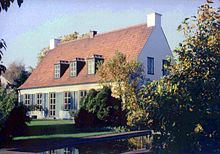Friedrich Schaub
Friedrich Schaub (born December 31, 1910 in Kanitz in Moravia ; † January 30, 2002 in Cologne-Rodenkirchen ) was a German garden and landscape architect and landscape designer. He was a pioneer of biodynamic farming and the early ecological movement in Europe.
Live and act

Friedrich Schaub was born as the son of the Kanitzer town clerk Karl Schaub and his wife Friederike Müller from Vienna . He grew up bilingual with German-speaking parents in a predominantly Czech circle of friends and life. After attending the Czech elementary school in Kanitz, Schaub studied gardening and landscaping at the higher fruit and horticultural school in Eisgrub Castle in South Moravia , which he graduated with the Matura in 1929 . After his military service in 1938 Alwin Seifert appointed him landscape lawyer for the Reichsautobahn Vienna – Wroclaw and worked until 1942 in collaboration with Alwin Seifert, Hermann Mattern and the civil engineer Hans Lorenz for the planning and design of the autobahn. Due to its late, well-engineered planning concepts, this only partially built motorway route set standards in many areas of motorway construction based on clothoid calculations and landscape images, which were required by Alwin Seifert and which were implemented and implemented in the early Federal Republic after the war, especially by the route specialist Hans Lorenz were published.
Also noteworthy Schaub's advanced planning is service area Boskowitz (ch. Boskovice) in Moravia, he in with the landscape architect and Anthroposophists Max Karl Schwarz (1895-1963) from Worpswede one of the first organic and biodynamic developed Rasthof concepts. Schwarz is considered an important pioneer of biodynamic agriculture . The Boskowitz service area was planned with an ecological economic cycle, an autonomous service area settlement and comprised a gardener's yard with a tree nursery, a farm with pigs and poultry, a dairy, a housing estate, a sewage treatment plant and the use of green forage through the motorway green areas. Schaub only realized the ideas and concepts for this gardener's farm after the war on his 2.9 hectare property in Cologne Rodenkirchen.
From his first city apartment, which he occupied as a refugee in the bombed-out Cologne, he built the new gardener's yard with a horticultural business, tree nursery and landscape architecture office for his growing family and was soon one of the most important garden architects of the Cologne reconstruction. Friedrich Schaub designed numerous gardens, villa gardens and gardens in Rodenkirchen, Cologne and the Rhineland , etc. a. for the Mülhens family ( 4711 ) and the 1957 Federal Garden Show in Cologne, together with the garden architects Herta Hammerbacher , Hermann Mattern and the Cologne gardening director Kurt Schönbohm . In addition, in 1954 Schaub designed and designed the outdoor facilities of the Federal Post Office , which is now the Federal Audit Office in Bonn. His specialties were the creation of rounded natural stone terraces and walls from a north German quarry, ponds, swimming pools and pergolas.
In 1939 Friedrich Schaub married the daughter of the lake and landscape painter Poppe Folkerts , Hanna Folkerts (1919–2005). The marriage had eight children.
The Gärtnerhof Schaub in Cologne-Rodenkirchen is the first work of the young architect and later professor at the Technical University of Munich Heiko Folkerts from 1953 to 1954. The Gärtnerhof counts through the history of its origins, the participation of various art, reform, architecture, natural and horticultural trends its influential representatives on the early examples of the ecological movement and had a decisive and trend-setting influence on ecological building in Germany. In addition to the 100-acre farms of the important GDR architect Hermann Henselmann 1941-42 in Balzweiler / Balczewo in the occupied Reichsgau Wartheland, it is probably one of the most important new building conceptions of the gardener's farm idea in Germany. The influence on today's biodynamic agriculture and the agricultural production cooperatives of the GDR by Henselmann has unfortunately hardly been researched.
After an application for a monument made in 2012 by the architect Heiko Poppe Folkerts and an unsuccessful appeal by leading German architectural historians such as Wolfgang Voigt from the German Architecture Museum in Frankfurt, Winfried Nerdinger , Hans Georg Lippert, Hartmut Frank, Wolfgang Sonne and Roland Günter as well as architecture professors such as Christoph Mäckler , Friedrich Kurrent and Elisabeth Schmitthenner , the Gärtnerhof Schaub was not entered in the list of monuments of the Rhineland by the city curator of the city of Cologne and the state curator in 2014 , so it was demolished prematurely in 2015 in favor of a new villa and irretrievably destroyed for research.
literature
- Charlotte Reitsam: Reichsautobahn in the field of tension between nature and technology. Diss. TU Munich. 2000.
- Charlotte Reitsam: The concept of 'down-to-earth garden art' Alwin Seiferts - technical background and reception until the post-war period . Frankfurt a. M. 2001.
- Alwin Seifert: German gardens from more recent times. With Herta Hammerbacher, Werner Lendholt, Hermann Mattern, Ludwig Roemer, Friedrich Schaub, Alwin Seifert, Otto Valentien. Baumeister 6/1950 Munich Callwey Verlag.
Web links
- Max Karl Schwerz, gardener, garden and landscape architect, Kulturimpuls research center
- Overview map
- The graduates from 1895 to 1942 of the higher fruit and horticultural school Eisgrub / Lednice in Moravia
- Der Spiegel 17/1962, road construction, egg with music about the routing specialist Hans Lorenz
- Karl Welbers, Norderneyer Kurier, Majestic mountains and monumental buildings with Gärtnerhof Schaub, Frida Folkerts and Hanna Schaub, (PDF; 222 kB)
| personal data | |
|---|---|
| SURNAME | Schaub, Friedrich |
| ALTERNATIVE NAMES | Schaub, Fritz |
| BRIEF DESCRIPTION | German garden and landscape architect |
| DATE OF BIRTH | December 31, 1910 |
| PLACE OF BIRTH | Kanitz , Moravia |
| DATE OF DEATH | January 30, 2002 |
| Place of death | Cologne-Rodenkirchen |
